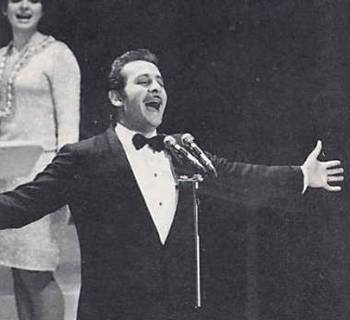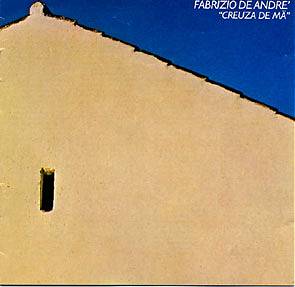Franco
Fabbri
Nowhere Land:
The Construction of a 'Mediterranean' Identity
in Italian Popular Music.

Domenico
Modugno at the San Remo Festival
|
The notion of Mediterranean-ness
has been circulating in Italian popular music for
decades. Since Domenico Modugno's success at the
1958 San Remo Festival with Nel blu dipinto di
blu, the idea of juxtaposing new songs inspired
by cosmopolitan models and the traditional models
of national popular music began to establish
itself. The problem arose as to how to
reinterpret references to the Southern
(especially Neapolitan) musical heritage which at
first seemed to be completely confined to the
traditionalists and preservationists, with the
exceptions of Modugno himself and Renato
Carosone. |
| It was not until the Seventies
that we find the trace of a new and explicit
integration of Neapolitan-ness into the corpus of
modern Italian popular music, and it was only in
the Eighties that the idea of a more general
membership of a 'Mediterranean musical culture'
began to appear. Fabrizio De André's album Creuza
de mä is exemplary for two reasons. It is a
deliberate project to reconstruct a new Ligurian
dialectal folklore based on retrieved elements
(without any particular rigor but following
certain distinct aesthetic criteria) from the
various traditions of countries surrounding the
Mediterranean. |

Creuza de
Mä
|
It also, unadvoidably, contains
references to the work carried out in those years by
musicians such as Brian Eno, David Byrne and Peter
Gabriel. Subsequently, the idea of Mediterranean-ness
wove its way through the Arabian fantasies of musicians
such as Franco Battiato, and became particularly
entangled with the new buzz word 'contamination' that had
become commonplace among the critics and the popular
music community in the 1990s, after the definitive
establishment in Italy of the generic-stylistic model of
'World Music'.
The study of the development of this abstract idea of
Mediterranean-ness, as contrasted with the concrete
instances of its implementation, presents a very good
opportunity to reflect further on how musical categories
are elaborated.
- The Mediterranean and
Naples
- 'Urlatori'
and 'melodici'. And 'cantautori'
- The eclipsing of the
Neapolitan song
- A tradition
to be invented
- Creuza de mä
- Ideology
and musical categories
- Bibliography
Notes
|

